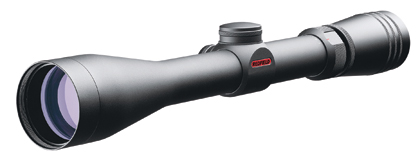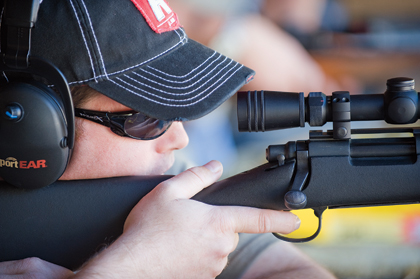September 23, 2010
By Joseph von Benedikt
Redfield is back, and its optics are built in the U.S.A. by America's most respected brand.
By Joseph von Benedikt
The first time I realized what a huge player Redfield actually used to be in the optics field was while reading Charles Henderson's book, Marine Sniper: 93 Confirmed Kills, about the legendary Carlos Hathcock.
If I recall correctly, Hathcock had a Unertl scope while in Vietnam, but many of the sniper rifles in use were fitted with Redfield Accu-Range scopes, and they were considered fine optics. At the time--four decades ago, and while this magazine was still young--Redfield held a position of envy, even among such sterling competitors as Leupold.
Advertisement
A lot of water has flowed under the bridge since then. Suffice it to say that in the 1990s Redfield's competitors put so much pressure on the company that in 1998 it closed its doors. It was a shame; the company was truly an American icon and only a decade away from becoming a century old. As I pen this, Redfield is 100 years old.
Several times the defunct company was sold. Rumors abounded: Redfield was back. Redfield was honoring warrantee claims. Redfield wasn't honoring warrantee claims. Redfield was being sold again. At least once, a massive new product launch took place, featuring a scope made overseas and sporting all sorts of innovative bells and whistles; in fact, it was covered here in the pages of Shooting Times. Yet product never hit dealers' shelves in numbers abundant enough to make a splash.
Advertisement
Then in April of 2008, Leupold, once one of Redfield's arch-competitors, purchased the Redfield brand.
Today, Leupold holds the envied position vied for by Redfield 40 years ago--that of America's premier optics manufacturer. Leupold made what I consider the smartest move possible in order to ensure the solidity of Redfield's future: The company announced an American-built Redfield scope--the "Revolution"--with traditional Redfield styling and modern features geared toward hunters. The firm is building said scope in its Beaverton, Oregon, plant, using the same particularly high-end materials, machines, and manufacturing techniques that Leupold scopes boast. What amazes me the most is that the scope (at least the initial 3-9X 40mm version) will sell for $149 dollars. Keep in mind, that's American made!Paraphrasing Leupold's Pat Mundy, the scope is intended to compete directly with similar-priced scopes imported from overseas. After spending some significant range time with the scope, I believe it will--to put it crassly--blow similar-priced imported scopes out of the water.
Specifications
As I mentioned, Redfield's Revolution is manufactured in Leupold's plant here in the good old U.S.A. The maintube is machined of 6061-T6 aluminum, and the lenses are ground from premium-quality glass and are multicoated. Said coatings are a multilayer, dielectric metallic compound that is applied to the lenses to improve light transmission by reducing stray reflection from the lens, which increases light transmission into the low 90s.
The erector assembly features intentionally beefed-up construction to provide ruggedness, and reticle adjustments are controlled by audible-and-tangible-click 1/4 M.O.A. finger-friendly Accu-Trac turrets.
The unit is purged with nitrogen against fogging and is fully waterproof. It's also touted as shockproof, which presents a challenge to the gleeful little equipment-testing troll that resides within me. However, I resisted the urge to roll the scope down the several flights of concrete stairs leading to my office, deciding instead to take the shockproof guarantee as it was probably intended: It should withstand recoil--even very heavy recoil--with aplomb.
 Classic in styling and cutting-edge in performance, the Redfield Revolution is an American-built optic for under $150. |
On that note, the Redfield Revolution comes with a full lifetime warranty.
I particularly liked the fact that designers had taken pains to use styling that was both reminiscent of old Redfields yet classically modern, providing a finished product with great looks and a sleek, ergonomic makeup. Any vintage Redfield aficionado looking at the new Revolution will recognize the three diamond-knurled rings around the ocular lens housing and other trademark elements derived from early Redfield optics.
The black matte finish is similar to but different from the finish used on Leupold scopes. The anodizing process is the same, but the texture created before applying the anodizing is different. Specifically, a different-size bead is used during bead-blasting to create a dull, very nonreflective, aesthetically appealing surface.
There are two choices of reticle: a 4-Plex provides shooters with a classic duplex-type crosshair, and the Accu-Range ballistic reticle provides long-range capability to hunters desiring holdover points.
Scopes are being offered in 3-9X 40mm (tested) as well as 2-7X 33mm, 3-9X 50mm, and 4-12X 40mm versions.
Field Work
The folks at Leupold kindly provided Shooting Times with a sample of the 3-9X 40mm scope mounted on a straight-shooting Remington Model 700 SPS rifle in .223 caliber. It zeroed quickly and easily, and while I did not initially perform any extended range tests, I was able to get it coyote-ready in a hurry when pressed for time.
 Redfield connoisseurs will note the three knurled rings on the ocular housing and the sleek, classic styling of the new Revolution. The high-texture non-glare anodized matte finish, on the other hand, is as purely modern as it gets. |
Unfortunately, I have yet to shoot at a coyote, but I have had time to take the scope back to the range.
The first real test I performed was to shoot around the square, starting by adjusting the scope to the upper right-hand corner of a target and shooting a five-shot group, then moving the reticle 32 clicks left, 32 clicks down, 32 clicks right, and finally 32 clicks up, shooting a five-shot group after each move. The first group and the final group landed in precisely the same spot, attesting to the consistency with which the mechanism tracks. Also, I found that the scope did not require one or more sh
ots to "settle" as many scopes do. Each first shot sent downrange after an adjustment had been made was right where it was supposed to be.
The one variation the test exposed was that the clicks, while close, do not move the reticle exactly 1/4 M.O.A. Actually, 32 clicks moved the point of impact roughly 9 inches instead of the 8 it should have. That factors out to one click equaling 0.28 inch instead of 0.25 inch. Big deal. Considering the consistency represented in bringing point of impact back to the same precise spot after shooting the square, it's a non-issue.
 The author spent considerable time at the range testing the Redfield's ability to track consistently throughout its magnification range and confirming the Accu-Trac turrets' ability to make precise, predictable adjustments. |
Next, I tested the Redfield's ability to track through its power range from high power to low and back again. Beginning at 9X, I fired a five-shot group, ran the power adjustment ring to the other end of its range, and shot a second group at 3X. Actual group size opened up a bit--a misty rain was coming down, and my ability to sight consistently diminished with the reduced magnification--but the second group was centered over the first. Running the magnification up to 6X for a third five-shot group and then back to 9X for a final group simply confirmed that the scope tracked perfectly, the 20 rounds tearing a ragged quarter-size hole with a few lonely shots dotted around it that I will cheerfully blame on the rain and wind gusts. Even with those factors, the entire 20-shot group measured only 2.25 inches.
Clarity is excellent, surpassed only by scopes priced many times its cost. Color fringing is basically nonexistent. Ocular adjustments are easily made and securely locked via the knurled ocular housing and lock ring. Eye relief is fairly generous at 3.7 to 4.2 inches.
I managed to suppress my urge to roll the scope down the concrete stairs, but I had to have a little fun, so I dumped the Revolution into a pan of water and froze it overnight. Later I baked it in my wife's gas oven for an hour at 150 degrees Fahrenheit; the hottest I figured it would ever get in real-life use.
Neither type of torture fazed it.
